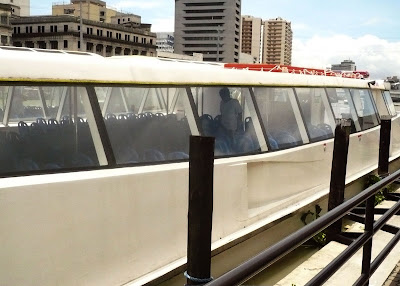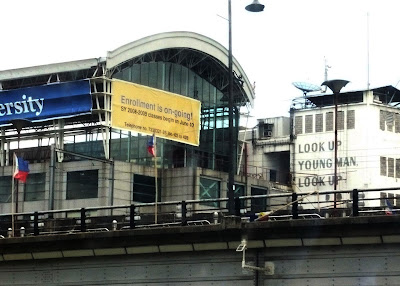
On the occassion of Araw ng Maynila (Manila Day), we first paid a visit to the long-abandoned and dreary Plaza Mexico on the outskirts of Intramuros (near the Bureau of Immigration in case you haven't got a clue where it is) and then took the 45-minute, 27-kilometre, Php 40-ride on the new Pasig River Ferry service from Plaza Mexico, Manila to Barangay Kalawaan in Pasig City (Line 1) and ends at Barangay Sta. Elena in the river city of Marikina (Line 2; the Marikina line is not yet operational as of this writing). We, however, hopped off at Guadalupe instead as we had no intention of going much further.
Anyway, you have no idea how truly excited I was to finally ride this thing. It's so fascinating to finally be able to traverse the length of the Pasig River - the same river that gave birth to the City of our Affections - and get a feel of its age, its whims and fancy, and its faded (but returning) glory.
The current Pasig Ferry service is not the first in these parts. It is antedated by the Magsaysay Lines (operated for only a year; Escolta to Guadalupe) and the Pasig Star Craft (began in 1997; Escolta to Bambang) by over a decade during the time of the Ramos administration during whose time the revitalization of the river was seriously undertaken under the Clean and Green Foundation headed by then First Lady Amelita Ramos.
The current service was inaugurated by the current President, Gloria Arroyo, on February 12, 2007. The project was built at the cost of US$ 176M and was financed by the Asian Development Bank under its Pasig River Environmental Management and Rehabilitation Sector Development Program. The service is expected to serve approximately 28,000 passengers a day.
There are fifteen (15) stations (or 14) on the route, each costing P80 million. The service is provided by twin-engined, double-hulled fiberglass catamarans manufactured by the Australia-based Nautical Transport Service, Inc. (NTSI), each costing Php 15 million. These are the same kind used on Sydney Harbour and Brisbane River and were designed by JSOPHIL Enterprises in association with Sydney-based Scott Cole (of Sidney Side Cruises) and built in Manila (in Pureza to be exact). Each catamaran has a length of 25 metres, speed of 22 knots and can accomodate 15o passengers.
The line is currently being operated by the Pasig River Rehabilitation Commission.
As El Cineaste wrote in skyscrapercity.com, "Help the Pasig River Ferry by taking it frequently. I have promised myself to ply it every weekend. It's really therapeutic; the river may not be like the Seine of France or the Thames of England, but [the] Pasig is as old and as historic as the aforementioned rivers."
Indeed. What a lovely way of putting it.


A beautiful view of the El Hogar, site location of many film and video shoots. In English, El Hogar means "the home." No idea if this is the building's original name. It was most recently used as a shoot site for a film entitled Room 213 by Keith Sicat.

A view of the Plaza Mexico station. The airconditioning is not working yet. It is very small. It doesn't look like it will cost P80 million to build it, but whatever. :-)
The adventure begins in the next entry.














































